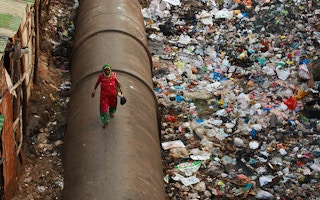Every day, after she finishes cooking, cleaning and fetching water for her tiny one-room home in India’s financial capital Mumbai, Saubhagya Nadelkari picks up a stack of leather strips and makes her way to her neighbour’s home.
There, in a narrow alley that is covered with plastic, about half a dozen women sit or stand as they braid long strips for use in belts, sandals and bags. They talk and laugh as their fingers fly, knotting each strip at the end when it is done.
“I have been doing this for about 10 years. We used to get more work, now we get less, and get paid less,” said Nadelkari, who makes about 100 pieces a day. She is paid about 24 rupees ($0.40) for a set of 12 finished pieces.
“We only get paid once in six months, and they don’t keep proper accounts. But my husband doesn’t let me go out and work, and we need the money, so I can’t say ‘no’ to the work.”
Nadelkari and her friends are among nearly 38 million home-based workers in India, according to a 2012 survey by WIEGO, a global non-profit focused on informal workers.
Restricted to their homes because of limited mobility and lack of childcare, they are engaged in providing low-paid manufacturing or services for local and global supply chains.
The women stitch garments, embroider and attach sequins, make shoe uppers, handicrafts, as well as roll incense sticks and prepare food items such as pickles.
Unlike self-employed home-based workers who sell their output directly, sub-contracted homeworkers are dependent on a middleman who drops off and picks up orders and keeps a part of the payment as commission.
“
Their situation is worse than a sweatshop, because at least in the sweatshop they don’t have to pay for electricity and water and rent and they get paid regularly.
Indira Gartenberg, researcher, LEARN
They are affected by fluctuating demand, cancelled orders, delayed payments and rejected goods.
“These are the most invisible of informal workers,” said Indira Gartenberg, who has researched home based-workers with non-profit LEARN in Mumbai.
“Their situation is worse than a sweatshop, because at least in the sweatshop they don’t have to pay for electricity and water and rent and they get paid regularly,” she said.
Economic compulsion
In India, the world’s fastest growing major economy, more than 90 per cent of workers - or about 400 million people - are in the informal economy, according to the Centre for Equity Studies.
Women and children in the informal economy are particularly vulnerable to exploitation.
The garment industry is particularly prone to abuse. Of the 38 million home-based workers in India, about 45 per cent are involved in making garments or textiles, and half these workers are sub-contracted homeworkers, according to WIEGO.
The piece-rate work that is common in the industry is low paid and seasonal. While the women do the bulk of the work, children pitch in during busy periods, even skipping school to work.
“Contract work for textiles has been growing exponentially because of the growing popularity of readymade garments and fast fashion, even in India,” said Shalini Sinha, WIEGO’s sector specialist for home-based workers.
“Many leading global brands are outsourcing to homeworkers, even if they are unaware of it. Homeworkers are the most vulnerable in the chain, yet they bear a lot of risks because the economic compulsion is so strong,” she said.
The supply chains of global fashion retailers have come under greater scrutiny since the Rana Plaza disaster in Bangladesh three years ago.
Despite pressure from activists, India has not endorsed the International Labour Organization’s convention 177, which requires member nations to adopt a national policy to improve the lives of homeworkers.
That includes counting them as labourers, and providing social security protection and adequate remuneration.
Activists including WIEGO are also campaigning for secure contracts, social protection, better remuneration and unions.
For Nadelkari in Dharavi, a sprawling slum that is home to thousands of homeworkers, all of these would be welcome.
“Until then, at least I get to do the work with my friends. We talk, we laugh. We forget how hard it is,” she said.
($1 = 66.947 rupees)
This story was published with permission from Thomson Reuters Foundation, the charitable arm of Thomson Reuters, that covers humanitarian news, women’s rights, trafficking, corruption and climate change. Visit news.trust.org to see more stories.

















